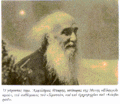Difference between revisions of "Patriarchal Exarchate of Patmos"
(Create page for Patriarchate Exarchate of Patmos.) |
m |
||
| Line 1: | Line 1: | ||
| − | '''Patmos''' (Greek ''Πάτμος'') is | + | The '''Patriarchal Exarchate of Patmos''' (Greek ''Πάτμος'') is the small [[w:Greek|Greek]] island pf '''Patmos''', also referred to as the '''Jerusalem of the Aegean Sea''', since it is the island of ascetic austerity. This exarchate belongs to the [[Patriarchate of Constantinople]]. |
| − | From the very earliest times, Orthodox tradition has associated Patmos with St. [[John the Theologian]]; on this island is the cave of his exile and from where he wrote the [[Book of Revelation]]. More specifically, it is remembered as the place where he recorded his vision from [[Jesus]] that came to us as the Book of Revelation. Revelation was written as an exhortation to the Christian believers to stay true to their faith during the persecutions near the end of the first century.<ref>P. N. Tarazi, ''The New Testament - Introduction, Vol. 3 - Johannine Writings'', St. Vladimir's Seminary Press, Crestwood, New York, 2004 ISBN 0-88141-264-3</ref> | + | == History == |
| + | Patmos is the northernmost island of the Dodecanese and is populated with [[church]]es and communities of Orthodox Christians. From the very earliest times, Orthodox tradition has associated Patmos with St. [[John the Theologian]]; on this island is the cave of his exile and from where he wrote the [[Book of Revelation]]. More specifically, it is remembered as the place where he recorded his vision from [[Jesus]] that came to us as the Book of Revelation. Revelation was written as an exhortation to the Christian believers to stay true to their faith during the persecutions near the end of the first century.<ref>P. N. Tarazi, ''The New Testament - Introduction, Vol. 3 - Johannine Writings'', St. Vladimir's Seminary Press, Crestwood, New York, 2004 ISBN 0-88141-264-3</ref> | ||
The whole island is dominated by the two monasteries, built in his honour and memory, and Chora, the island’s historic center, are all declared World Heritage sites by UNESCO in 2006. | The whole island is dominated by the two monasteries, built in his honour and memory, and Chora, the island’s historic center, are all declared World Heritage sites by UNESCO in 2006. | ||
| Line 20: | Line 21: | ||
Image:PatmosV.JPG|Monastery of the Apocalypse - View of Patmos from inside the Cave | Image:PatmosV.JPG|Monastery of the Apocalypse - View of Patmos from inside the Cave | ||
</gallery> | </gallery> | ||
| + | |||
| + | == List of Churches and Monasteries == | ||
== Saints and Monastics == | == Saints and Monastics == | ||
Revision as of 00:09, May 5, 2008
The Patriarchal Exarchate of Patmos (Greek Πάτμος) is the small Greek island pf Patmos, also referred to as the Jerusalem of the Aegean Sea, since it is the island of ascetic austerity. This exarchate belongs to the Patriarchate of Constantinople.
Contents
History
Patmos is the northernmost island of the Dodecanese and is populated with churches and communities of Orthodox Christians. From the very earliest times, Orthodox tradition has associated Patmos with St. John the Theologian; on this island is the cave of his exile and from where he wrote the Book of Revelation. More specifically, it is remembered as the place where he recorded his vision from Jesus that came to us as the Book of Revelation. Revelation was written as an exhortation to the Christian believers to stay true to their faith during the persecutions near the end of the first century.[1]
The whole island is dominated by the two monasteries, built in his honour and memory, and Chora, the island’s historic center, are all declared World Heritage sites by UNESCO in 2006.
Monastery of St. John the Theologian
Cave of the Apocalypse
List of Churches and Monasteries
Saints and Monastics
Ancient Icon of St. John the Theologian
Notes
- ↑ P. N. Tarazi, The New Testament - Introduction, Vol. 3 - Johannine Writings, St. Vladimir's Seminary Press, Crestwood, New York, 2004 ISBN 0-88141-264-3








